
|
|
||
 |
||
Content highlights:
Omega Quartet
Searching rehearsals - Gilbert Biberian
Augustin Barrios Mangoré
Barrios, modern troubador - Colin Cooper
Julián Carrillo - John Ford
Composing around a fret - Reed Maxson
Prelude - Reed Maxson
Letter from England - Graham Wade
|
|
||||||
|
CREATIVE GUITAR INTERNATIONAL
© 1975 by Ruth and Jerry Mock, editors and publishers, Creative Guitar International is a classic guitar magazine published three times a year, in the fall, winter and spring by Mockingbird Press, Edinburg, TX 78539, USA. Subscription rates $5 a year; two years $10. Overseas subscriptions by surface mail. For overseas air mall subscription add $3 a year.
CONTENTS
|
||||||
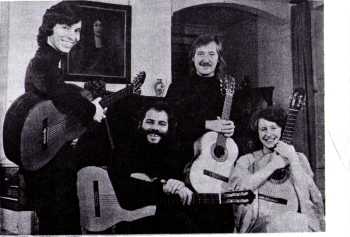 |
||||||
|
3
6
8
9
11
12
15
17
20
23
24
26
27
29
30
32
33 34 35 36
38
|
Omega Quartet: New directions
Biberian: Probing rehearsals Mangore revival timely Barrios: Modern troubador Carrillo after 100 years Facsimile of Carrillo manuscript Review; Bone unrevised Composing around a fret Prelude |
Gilbert Biberian
Colin Cooper John Ford
John D. Roberts
Reed Maxson Ruth Mock
|
||||
|
Counting outdated?
An Ark lark; Music, art center
Teacher's aid
|
||||||
|
Current discography
Guitar in Poland
|
John W. Tanno Frank Wagner
|
|||||
|
Events: Holland; 31, Palma de Mallorca, Colorado Society
competition; Angel Arellano Gonzalez performs in Mexico;
Grants for Guitar Workshop.
On campus: Music, art offered; Universities: Roosevelt, Pan
American, Idaho, Denver, Southwest Missouri
Letter from England Graham Wade
Letters; Performance risks Paul Hinrichs
Teacher directory; Want ads
Letters: Hong Kong attendance good; Travels from Singapore
for performance; Program in Sweden; 37, Children tested in
Germany; Lute Society librarian; One-day festival; Carmel
program reset
Books on guitar building; Lopategui of Spain records Sor
|
||||||
|
Gregory Piklei
|
Gilbert Biberian Colin Downs Helen Kolamuniak
|
|||||
|
The guitar is moving in new directions, as illustrated by the British group, the Omega Guitar Quartet, and its leader, Gilbert Biberian.
The Omega group plans performances in the U.S. this fall and in January 1977. Biberian made an impressive appearance at the recent Classical Guitar Symposium in Toronto, attended by 500 guitarists.
When the Omega Quartet was formed in 1969, chamber music for guitars alone was scarce. Now the quartet has a repertoire of more than 25 numbers, including transcriptions and original works.
Biberian founded the Omega Players, which also included
|
||||||
|
The cover, "Gypsy's Lament", was drawn for CGI by artist Gerald A. Shafer of San Benito, Texas.
|
||||||
|
|
||||||
|
|
|||
|
Creative Guitar International 4
the Omega Quartet.
Biberian was born Feb. 19, 1944 in Istanbul, and moved to England in 1959. He studied at the London College of Music, 1963-65, and Trinity College of Music, 1965-68. He studied composition under Hans Keller and Elisabeth Lutyens, and guitar under Ida Presti and Alexandre Lagoya.
Biberian has performed as a solo guitarist, as well as in ensemble. Following his London debut in May, 1969, the London Times critic said, "unlike many of his colleagues, Mr. Biberian deserves his following." After a recital at the Purcellroom the Daily Telegraph spoke of him as "that rare spirit, a guitarist who concentrates on advanced compositional techniques", and as being "musically aware of his own times."
Joyce Sclar wrote one of two reports on the symposium published in the Newsletter of the Guitar Society of Colorado. She wrote about Biberian's workshop on duo playing:
"He is a young, dynamic, elequent teacher...Every suggestion Biberian made was based on the harmonies implicit in the music and he took the time to show and illustrate them to the class."
"... to emphasize articulation, try running scale passages contrary to their usual dynamic markings.. .i.e., play a rising scale passage diminuendo instead of crescendo. Watch for interior rhythmic accents inside each measure, being sure to emphasize them, thus minimize the heaviness of the usual first downbeat and give the music more of a lilt and lift. (This subtle modification of tempo is referred to as an agogic accent.) He also recommended playing melodic passages harmonically, and vice versa: Looking for harmonics implied in what would appear to be only melodic sections. This presupposes a good knowledge of... theory on the performer's part. When practicing, Biberian feels the body must be... relaxed. To achieve this, he mentally centers his frame on his buttocks and allows everything else to be limp, surrendering all to the force of gravity."
Biberian has been responsible for the creation of many
|
5
|
||
|
new works for the guitar, including "The Dying of the Sun," by Elisabeth Lutyens, recorded by the British Broadcasting Company for the program Music in Our Time.
Biberian has written three song cycles, music for an educational TV series and a documentary film, a number of chamber works and four quartets for the Omega Quartet.
Some of his recent engagements have included a European tour with the London Sinfonietta under the direction of Pierre Boulez, and Luciano Berio.
The Omega Quartet has received considerable critical acclaim, which included some interesting reaction to the guitar repertoire.
About the Omega Players, the London Times wrote (May 5, 1971): "...a welcome move away from the monotonously small-scale fare of solo recitals". "The range of effect is sufficiently impressive to suggest how conservative nearly all solo writing for this instrument so far has been."
Also: "Their repertory of new music and the range of sonorities to be obtained from their instrument are like a breath of fresh air after the majority of guitar programmes," Daily Telegraph, Dec. 6, 1973.
N. Soames in the Hampstead and Highgate Express, June 1971, "...a new ensemble to release the classical guitar from its largely hackneyed repertoire..."
Biberian and his group also have experimented with instruments. Both of his quartets are scored for two regular sized guitars and two requintos. They tune the requintos a fourth higher.
In addition to the Biberian quartets, the Omega repertoire includes:
Four guitars: Tread Softly by John Lambert (1970); Sunrise Song by James Patten (1973); Unay Diez by Jorge Labouve (1373); Concerto "De Angelis" by R. Smith Brindle (1973); Reflected in Tranquility by David Carhart (1973).
Two requintos, two concert guitars: Quartet by Michael Watkins (1972); Suite by W. Brade-Downs.
|
|||
|
|
|||
|
|
||||
|
Creative Guitar International 6
Soprano and four guitars: Mosquito by Michael Kelly (1969).
The Omega Quartet was scheduled to perform at Carnegie Recital Hall, New York, Oct. 21, in Miami Oct. 23, and in Toronto Oct. 31. Biberian was scheduled to hold master classes in Toronto Nov. 3-7. The group is scheduled to return to the U.S. for a more extensive tour in January 1977.
By Gilbert Biberian*
Originally there were eleven of us! I conducted a great deal in those days. We played works for various combinations of guitars, with or without percussion, in groups of ten, nine or eight, with the redundant ones doubling on percussion. In concert, we would include works for four guitars and sometimes add voice as in the "Arie Antiche" by Scarlatti and Caldara. This used to make a very impressive contrast. But nothing was so exciting as the ten players playing together especially in such a work as, say, John Lambert's "... But Then Face to Face..." which was scored for ten guitars., a massive array of percussion, piano, organ and voice!!! What a spectacle! Recently I gave a lecture for the Greater London Education Authority during which I played excerpts from the major works that had been composed for my group. It was very exciting. I regret to say that the group of ten is no more as it was too large a body of musicians to keep together without money. We worked solidly for three years without so much as a cent going into our pockets. Any money we earnt was put back into the group, initially to buy percussion instruments and later to finance our concerts, which, as you know, are costly affairs. Eventually we disbanded (although in my heart of hearts I think, temporarily) and concentrated on the quartet. I must not forget to tell you that in the three years of our existence we gave birth to 24 new works, all of which we performed !
We now channel all our energies into the quartet and, naturally, the results are far greater as we can move about far more easily and at a less expense. So, the quartet was formed in 1969 at the same time as the group of ten. We rehearse three times a week whether we have concerts or not and nearer the time of a concert we have been known to rehearse every day! Our rehearsals are searching and meticulous. We
*From a letter to CGI by Biberian.
|
7
|
|||
|
try to deal with problems of ensemble and balance. After this we devote a great deal of attention to detail and interpretation. I am of a rather analytical bent of mind and I enjoy unravelling a score (in fact I often give classes on interpretation to pianists, violinists, singers, etc. and enjoy teaching the Bach, Mozart, Beethoven et. al.) consequently our rehearsals are experiences in themselves from which I, for one, and I know the others learn a great deal.
We transcribe our own music although other people have provided us with transcriptions, especially for us, and they have been particularly successful.
I compose all the time and I have four quartets, long ones at that! to my name. I never tire of chasing other composers, however renowned or remote, in order to persuade them to write new works for us. And, gradually, my efforts are beginning to bear a little fruit.
BIBLIOGRAPHY of guitar works by Gilbert Biberian:
|
||||
|
CHAMBER MUSIC
Eight Bagatelles (1974). For cello and guitar. Sculptures (1967). For guitar and brass ensemble.
Concerto for guitar and wind orchestra (1975).
Sonata for flute and guitar (1967). TEN GUITARS AND PERCUSSION
Prisms, No. 1 (1969). Prisms, No. 2 (1970). FOUR GUITARS
Quartet No. 1 (1972) Quartet No.2(Primavera)(1973). Quartet No. 3 (1974). Quartet in C (1971). Suite (Novel lo, 1969). Five Valses (1971-74). TWO GUITARS
Sonata No. 1 (1967). Composed for the duo Presti-Lagoya. Sonata No. 2 (1973). |
12 Etudes (1966-1975).
SOLO GUITAR
Greek Suite (Broekman and van Poppel, 1965). Prelude and Fugue (Novello, 1967).
Sonata No. 1 (1967). Sonata No. 2 (commissioned by Stichting Gitarrweken, Zwolle, 1975). Prisms No. 3 (1970). Fifty Studies (1966-1974). GUITAR AND VOICE Epigrammes for voice and four guitars (Berben, 1967). Poems by De Cailly.
Cantos Nuevos (1967). Poems by Lorca, for speaker, tenor and guitar. Upon Julia's Clothes (1966). Poem by R. Herrick. The Sick Rose (1967). Poem by WT Blake
Serenade (1972). For soprano and four guitars.
|
|||
|
In 1974 we sent money to BMG for subscription, small ad. Someone cashed our check, but we didn't get BMG and no one we know has seen the ad. BMG still in business ?
|
||||
|
|
||||
|
|
|||||
|
9
|
|||||
|
|
|||||
|
|
|||||
|
|
8
|
||||
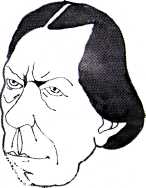 |
|||||
|
|
Colegio Nacional in Asunción, receiving honors in music, journalism and mathematics.
From 1910 he toured South and Central America, later billing himself as "Nitsuga Mangoré--the Paganini of the Guitar from the jungles of Paraguay." Nitsuga is Augustin spelled backwards. Mangoré was a legendary Guarani Indian chief who stole a Spanish conquistador's wife. By 1934 he became simply Augustín Barrios Mangoré.
From 1934 he toured Europe. By 1938 he returned to Mexico City, where he received a heart attack. In 1939 he settled in San Salvador, where he was professor of guitar at the National Conservatory.
Richards wrote that for many present it was the first "...time they had heard the music of the extraordinary Paraguayan composer." Richards wrote that "Stover's playing was animated and musical, and many pieces were introduced by interesting commentary."
Of his Barrios works, Stover wrote that "Three books of 20 pieces each, ranging from easy to medium to difficult, are already under way and should be out later this year. Also several solo pieces will be published, including two pieces for guitar duo which Barrios wrote. By next year there should be a total of 70 or so pieces by Barrios published!"
By Colin Cooper
Many guitarists know Danza Paraguaya/ by Augustín Barrios, even if they can't quite manage the difficult stretches. Owing mainly to the enerty and initiative of John Williams, many more of this prolific composer's works are being brought to the attention of the British concert-going public. Barrios is emerging with Schubertian proportions, not only in the abundance of his work but also in its quality. In a recent BBC interview conducted by Peter Sensier, Williams told how he selected a number of pieces from a pile of music in the possession of a disciple of Barrios (1885-1944). Other pieces he chose from recordings made by Barrios himself, who made perhaps the first classic guitar recording in 1910. Williams now has between 30 and 40 Barrios works literally at his fingertips, and to judge by the selection
|
||||
|
personality with an elusive Mangoré
background. He was ignored by the British biographer of guitarists Philip Bone, and mentioned only briefly by the Argentine Domingo Prat who referred to Barrios' "bohemian and artistic temperament," praising him as an "able and artistic performer."
Writer Charles Richard informed us that "literature on Barrios known to me is found in: Juan Max Boettner, Música y Músicos del Paraguay, which contains a bibliography concerning Barrios, as well."
Richard Stover of the University of California, Santa Cruz, has collected works by Mangoré and wrote that he is preparing for publication "the entire works" of Mangoré to be published by Belwin-Mills of New York.
In a program he gave recently at UCSC, Stover gave a biographical sketch of Mangoré, and wrote about the music he performed--an all Mangoré recital. The following was taken from Stover's program:
Mangoré was born in San Juan Bautista de la Misiones in Paraguay. As his large family esteemed both literature and music, he began to play the guitar young. He used his guitar in studying harmony at a Jesuit primary school. His first classic guitar teacher taught him from the Sor and Aguado methods as well as the music of classic guitar composers Tárrega, Areas, Viñas and others. At 13 he attended the
|
|||||
|
|
|||||
|
|
||||
|
Creative Guitar International
|
10 he played during the programme most of them are well worth the effort.
|
11
|
||
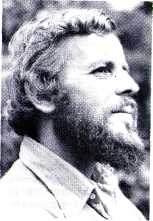 |
||||
|
By John Ford
Julián Carrillo (1875-1965), a Mexican composer-violinist, invented a musical system along with a new method of notation. For his system which he called sonido trece (the 13th sound), he composed a body of literature, including works for solo guitar and guitar with other instruments. Sonido trece is based on microtones, the half tones of the standard Western 12 tone system broken up into fractions—quarter tones, eighth tones, 16th tones, etc.
In order to perform these works, the fingerboard of the guitar must be altered. For guitar works in quarter tones, frets must be inserted midway between existing frets. Carrillo also wrote Estudio for a guitar with seven strings in thirds of tone. The strings are tuned in whole tones. Gerald R. Benjamin, musicologist and director of Latin American Studies at Trinity University, San Antonio, Texas, told me that the seven-string guitar was to be tuned e, f#, g#, a# c, d, e' (whole tones).
Carrillo's daughter, Dolores ("Lolita") Carrillo, is cultural attache of Mexico in New York City and coordinator of activities for Mexican artists with the U.S. She told me that her father never wrote music he was unable to perform. She told me the story of a cellist who came to Carrillo with a performance problem involving one of his compositions. Carrillo asked the cellist to show him the problem. After the cellist attempted unsuccessfully to play the music, Carrillo demonstrated another, plausible way to finger the music.
Carrillo also had guitars built to perform his music. One of these guitars is in his home in Mexico City. In this series of articles, I will explain Carrillo's notation system, give a bibliography of his works involving the guitar, as well as a brief biography of this remarkable man.
It is my wish to perform a selection of works written for quarter tone guitar by Julián Carrillo.* As the project of learning the compositions progresses, it should be interesting to note how the notational
|
||||
|
It is always difficult to pinpoint just what it is about a composer that is attractive. John Williams left listeners in no doubt that the warm spontaneity of Barrios' music, together with the richly idiosyncratic quality of the technical writing for guitar, were the things that he himself responded to. His subsequent playing confirmed his spoken statements; here was guitar playing of the very first quality, technically assured (as always!) but with the added dimension of a wholehearted response to the music.
|
||||
|
|
||||
|
COLIN COOPER
|
The rich and woody tone of Williams'
|
|||
|
guitar, especially when he was demonstrating Barrios' liking for third string melody, was remarkable: Not at all like his "classical" tone, it seemed to imply a spontaneity that matched the composer's own. The compositions of Barrios, ranging lyrically over the entire fingerboard with apparently effortless mastery, are a celebration of the guitar; and John Williams' way of playing them is a celebration of that fact. "I am a brother to those medieval troubadours who in their glories and despairs suffered such romantic madness, " wrote Augustín Barrios. Perhaps if they'd had persuasive champions of the calibre of John Williams, they wouldn't have suffered so much. Some published Mangoré compositions:
|
||||
|
Braziliance Music, Studio City, CA:
Aconquija (from Suite Andina)(BP69)
The Cathedral (La Catedral)(BP582) Breitkopf & Hartel, London
Choro da saudade (Arr. Cimma) Di Giorgio, Sao Paulo
Selecas de Musicos para Violao de
Augustln P. Barrios". G. Ricordi & Co., Buenos Aires:
Preludio, Op. 5, No. 1
Waltz, Op. 8, No. 4
|
Union Musical Espanola, Madrid:
Angelita (tango, Azpaizu)
Cantos Andaluces (medley, Sanchez
Granada).
Farruca Gitana (Azpaizu)
Guajiro (Azpaizu)
Zacateque (Azpaizu) G. Zanibon, Padova:
Danza paraguaya (Diaz)(5296)
La catedral (Diaz)(5311)
Oracion, melodia popolare
(Diaz)(5263)
|
|||
|
*Ford also has transcribed, and performed, on the guitar, a piano work by Carrillo.
|
||||
|
|
||||
|
|
|||
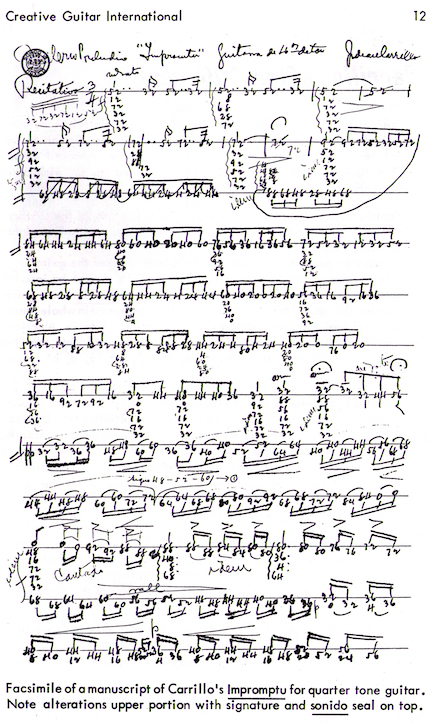 |
13
|
||
|
system fits into the idiom of the guitar; what kind of adaptations, if any, might be necessary to render the works more idiomatic.
PART I: NOTATION
Julián Carrillo wrote, in his Sistema general de escritura musical (Mexico, 1957) that "... humanity ought to be able to read and write music as easily as they might write a letter or read a newspaper." Therefore, he invented a new musical graphic system of numbers with which he could write whole tones, half tones or microtones (intervals of less than half tones) without using special music paper, and without using accidentals.
When writing 16th tones, Carrillo would use 96 numbers, as there are 96 intervals to the octave. In a whole tone scale, C would be zero, D 16, E 32, F#48, etc. A half tone scale would include in-between intervals: C 0, C# 8, D 16, etc. In quarter tones, C is 0, C# 8, and the quarter tone between is 4. In eighth of tones, 2, 4 and 6 are the intervening intervals between C (0) and C# (8). In 16th of tones, 2, 3, 4, 5, 6 and 7 are in-between intervals.
Carrillo perfected this system of his to the point that on plain lined writing paper, he could write all existing music. Three octaves could be notated with the use of a single line: One under the line, one on the line, and one above the line. An explanation of his system of notation can be found in his Preludio a Cristobal Colon (New Music, 1944). He shows placement of Cs (0) which could apply to other notes also:
|
|||
 |
|||
|
The lower notes are notated with the aid of a dash under the fixed line; the three middle notes on and about the line; and the higher ones over the fixed line, also with a dash.
Only the numbers 1 -12 are necessary in the notation of the classical music system of twelve tones, each number for each note.
All note cycles begin with C, which is represented by 0.
|
|||
|
|
|||
|
|
||||
|
Creative Guitar International
|
14
|
|||
|
|
||||
|
15
|
||||
|
|
||||
|
The fixed line may be referred to as the absolute do (C) line. No change exists in the notation of rests and, in the revised classical system, all instruments are notated as they sound. Transposition is eliminated!
For more on Carrillo's notation system, see Yearbook, Inter -American Institute for Musical Research, iii (1967), "Julián Carrillo and 'Sonido Trece'," by Gerald Benjamin.
BIBLIOGRAPHY of works by Julián Carrillo for and with guitar in the sonido trece system:
|
Review: Bone unrevised
The Guitar and Mandolin, Biographies of Celebrated Players and Composers by Philip J. Bone. Schott & Co.
This is an unrevised reprint of the second edition of 1954. It is an irrelevant book, and to put it into anybody's hands as a dictionary of guitarists is a mistake. The non-commital title gives a misleading impression that the book is a general work. It deals chiefly in fact with Austrian and German players; and this should be made clear in the title.
The Hispanic world, whose fundamental importance cannot be denied, accounts for less than one-seventh of the entries, and much less than one-seventh of the space. What can be said of a book that gives more space to Shand than to Segovia, more to Shelley than to Pujol? Where Donizetti, for one song with guitar accompaniment gets as much space as Castelnuovo-Tedesco, where Sainz de la Maza gets half the space devoted to Mayseder, who wasn't a guitarist at all? Worse, the point of view as regards the guitar is not that of 1954, but of about 1900. For Bone, the vihuelistas and the Baroque were as imponderable as the 20th century.
The Author's Note says "The research once begun, a revelation of the early and honourable position of these instruments dawned..." Not so; most of the players dealt with used the guitar, from necessity or choice, as a second string, and had little conception of it as a solo instrument, regarding it as a receptacle for pot-pourris, bagatelles, and "Favorite Airs." The time was a period of recession in the history of the guitar; the early music was forgotten, the present flourishing was yet in the future. The guitar was the instrument of accompaniment, and to discuss all who treated it as such would mean dealing with every musician between 1750 and 1850.
The book is diffuse; much space is given to famous composers of the last century who were unlucky enough at some point in their lives to pick up a guitar or a mandolin. Berlioz and the guitar, an old red-herring, gets five pages
|
|||
|
INSTRUMENTAL, concerto-like. Concertino for violin, guitar, cello in fourths of tone; octavina in eighths of tone, harp and horn in 16ths of tone; orchestral accompaniment in semitones. Three movements. 1927, recorded 1961.
INSTRUMENTAL, chamber. Preludio a Colón for soprano, guitar, flute, and violin in fourths of tone; octavina in eights of tone and harp. 1925. Recorded by Columbia Records.
Ave María for chorus, flute, violin, cello, guitar in fourths of tone; octavina in eighths of tone; arpa-citarra in 16ths of tone. Leonso Solemne (En los montañes de mi México) for violin, cello, horn, guitar in fourths of tone; octavina and arpa-citarra in 16ths of tone. 1926. Sonata casi-fantasia for violin, horn, guitar, octavina, cello and harp in fourths, eighthsand 16ths of tone. 1926.
Preludio "Ensueño" for mandolina, mandola and guitar in fourths of tone. 1928. Seis Preludios "Europa" for soprano,flute, violin, guitar in fourths of tone; octavina in eighths of tone; arpa-citarra in 16ths of tone.(Only fourth Preludio is extant).
(To be continued).
|
DRAMATIC, choral.
"I Think of You", Romanza for soprano, two violas, octavina, flute and guitar in fourths of tone; arpa-citarra in 16ths of tone. 1928. "La virgen morena" for double-bass, chorus (SSAA), violin, cello and guitar in fourths of tone; arpa-citarra in 16ths of tone and campana. Written for film by the same name. 1942. Dedication: "La música que oyó Juan Diego cuando se le apareció la virgen de Guadalupe in el cerro del 'Tepayac.'" (The music that was heard by Juan Diego when the virgin of Guadalupe appeared on the hill, "Tepayac." SOLO GUITAR
Estudio para guitarra ("A Media Noche en Oriental") in fourths of tone. 1931. Estudio para guitarra de siete cuerdas (of seven strings) in thirds of tone. 1962. Strings are tuned in whole tones. Suite (Impromptu) para guitarra in fourths of tone. Four movements. Sonata para guitarra in fourths of tone. Three movements. 1960. Doce Estudios para guitarra in fourths of tone. |
|||
|
|
||||
|
|
|||||
|
Creative Guitar International
|
16
|
||||
|
|
|||||
|
where five lines would do. Weber, because he sang to the guitar, gets seven pages; Handel, because "in at least one of his oratorios he writes apart for mandolin", gets two and one-half; Mozart for little better reason, five; Beethoven, likewise, six.
The case of Schubert is interesting. Bone devotes a page to the quartet with with a guitar part. Otto Deutsch*, who should know, wrote (in 1946, so before Bone's second edition) simply this: "The so-called guitar Quartet of 1814 is a Notturno for flute, viola and guitar by Wenzel Matiegka for which Schubert wrote only an additional cello part.. .for his father." (Deutsch, p. 38).
Bone devotes five pages to Schubert, but Deutsch does not return the compliment. He has only a few lines about the guitar, mainly on song accompaniments.
Bone says (p. 46): "Ill health compelled Boccherini to discontinue playing the cello, and he studied the guitar." Does this make sense ?
Many of the shorter entries are of flautists, violinists, cellists, whose biographies have little connection with the guitar. At the end some unimportant guitar works are mentioned, as an afterthought.
As if this were not enough, the book is full of errors, important and unimportant; if any error in a book of reference can be unimportant. Among errors that seem important: Sor is made to come to England in 1809, although Brian Jeffery assures me that he didn't leave Spain till 1813. The dates of Corbetta's birth and death are both wrong. Corbetta died in 1681; this does not deter Bone, who has him singing to Charles in 1685, and forced to flee in 1688. Bone likewise keeps Giuliani playing long after his death, although this is mentioned on page 8 of the Giulianiad, a paper that Bone had examined (p. 143).
Minor errors, if we admit such, are more than plentiful. On p. 352 the name of the guitarist (given by Prat**), who helped Stravinsky was Rodriguez Aravena, not Aravena
*Biographer of Schubert.
**Domingo Prat, Diccionario biográfico de guitarras y guitarristas (Buenos Aires; 1934).
|
Rodriguez. On p. 325 Segovia was not born on Feb. 27, 1890, but on Mar. 17, 1893 (Prat), and on p. 288 Pujol did not meet Tárrega in 1900 but in 1902. On p. 111 the Homage on the Tomb of Debussy was not Falla's most celebrated work for the guitar but his only one.
In conclusion let me say that the amount of useful information in the book would fit easily into a quarter of its pages, and that its republication uncorrected was an insult to the intelligence of the average guitarist.
John D. Roberts
As a guitarist-composer, Reed Maxson understands that the instrument poses special problems for those not familiar with it, but who want to write for it.
Maxson, a 1973 graduate with honors in composition from the University of California at Davis, has devised a system for composing for the guitar which he used on his
|
||||
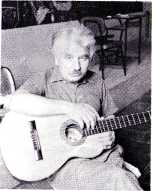 |
 |
||||
|
John D. Roberts in London, author of the review of the Bone book (pp. 17-19), and his mother, also his student, who has given several recitals. In regard to teaching his mother, in her 70s, Roberts wrote;
"My own view is that it is not her age that is in question, but my Method—you will say this is chauvinism."
|
|||||
|
|
|||||
|
|
|||
|
19
|
|||
|
|
|||
|
composition Prelude reproduced on pages 20-21.
Maxson studied guitar under Howard Heitmyer and Manual López Ramos. On request from CGI, he produced a careful and sensitive reading of the Prelude on tape. He also explained in detail how he composed the piece, as well as how someone else could also write in this manner. This Prelude is part of a larger work for guitar and was "chosen for discussion because its simplicity does not obscure the compositional system to be discussed."
His approach follows the design of the guitar, using a fret as a center, or axis about which a group of notes can be written. He uses the term pitch aggregates for this note grouping and calls the fret around which they are written an axis-fret. Two frets on each side of the axis-fret are easily available, making a chromatic range of nearly 2 1/2 octaves.
Maxson also refers to pitch generation, which occurs when a pitch other than the axis-fret pitch is used. This new pitch becomes the generator of its complement (fulfilling) pitch. In Prelude, every five measures are indicated with an m prefix for easy reference. In measures 8-10 the second fret is the axis fret. The E and A are axis-fret pitches. The C is one fret "below" the axis and therefore is the generator of its complement which is the D one fret "above" the axis fret.
Pitch generation in the above manner produces groups or aggregates of pitches which are symmetrical, at least in relation to the physical positioning of the pitches on the fingerboard of the guitar. Maxson illustrates this symmetry by transcribing the the work onto a tablature (Example 1).
Variations of this approach can be made which may, or may not produce symmetry.
Left hand fingering can be a consideration, Maxson wrote, as it "should not be more or less difficult than the music necessitates." He pointed out that in measure 11 the B is a complement to the preceding G "and as such it should be played on the third string, fourth fret. However, if the B is played on the second string, open, the phrase is more
|
 |
||
|
Example 1. Notation of Prelude in tablature, showing groups or aggregates, for the first 20 measures. m5-m7 is another version (permutation) of m1-m4. M11-13 is a further permutation. M14-16 a modulation (pitch change) to the sixth fret. Maxson suggests several ways of grouping pitches. For example, a complementary (fulfilling) note can follow its generator (the note which initiates the aggregate, or group design), or it can be delayed. Other pitches can separate a generator and its complement, or the generator and complement can appear at the same time (presentation through simultaneity).
sustained because the preceding G is allowed to resonate. If the performer decided to play the B on the closed string, however, the reason for doing so would not be because this B is the compositional complement of G, but because the performer believes that the closed B is an effective timbral contrast to the open B in measure 12, and that the resultant alteration in the rhythmic flow of this phrase is desirable."
The approach in Maxson's Prelude is that of working through symmetrical formations. ".. .while tonal areas are more or less defined in the Prelude, tonality is not dictated by the compositional system employed. The kind of tonal organization (or 'lack of organization') to be used within this system is determined by the composer." Therefore composers of "contrasting schools of thought are provided with a means of approaching the guitar."
Maxson gave this elaboration on contrasting schools:
"Within the system which was used for composing the Prelude, it is possible to generate secundal chords (chords built of superimposed seconds), tertian chords (chords of thirds), and quartal chords (of fourths). It is also possible to generate major, minor, and scales of other modes.
(continued on page 22)
|
|||
|
|
|||
|
|
|||
|
By Reed Maxson
Espresslvo - Sostenuto e poco rubato. Expressive, sustained, and with (a little) controlled flexibility of tempo.
False harmonics (also octave harmonics.) The note desired is played on the left hand. The index (1st) finger of the right hand touches the string over the 12th fret above the note played by the left hand. The note is plucked, giving a harmonic of the pitch notated. The note can be plucked with the anular (ring finger) or the thumb. Maxson wrote that "Where possible, as in the Prelude, I pluck the strings with my thumb instead of with my anular because I believe I can attain a fuller tone."
Cresc. - Crescendo. GraduaIly become louder.
Dim. Diminuendo. Gradually become softer.
Sul tasto - Play near the fingerboard.
Ponticello - ma non troppo. Play near the bridge, but not excessively.
Sulla bocca - Near the mouth, i.e., soundhole.
Morendo. Fading.
Sub, p. Suddenly soft.
,Sub. f. Suddenly loud.
|
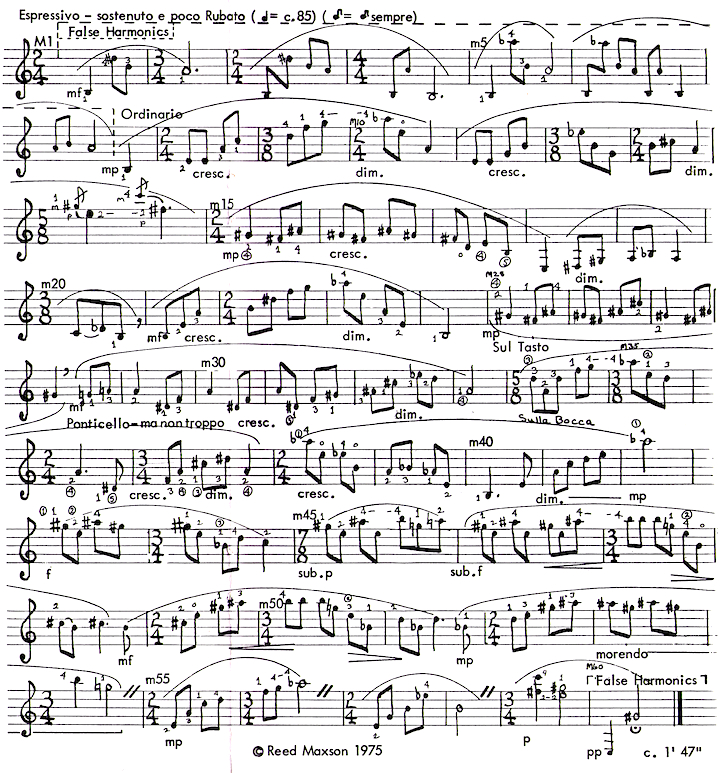 |
||
|
|
|||
|
|
|||||
|
23
|
|||||
|
|
|||||
|
Creative Guitar International
|
22
|
||||
|
|
|||||
 |
Counting outdated?
Lois Shishido, Basic Rhythms; Lois Shishido and Yoshio Matsumoto, Manual for Basic Rhythms, Box 127, Buena Park, CA 90621.
When Lois Shishido first inquired about advertising in CGI, claiming a
|
 |
|||
|
Example 2. This detail of m47-54 illustrates some permutations around on axis-fret by expanding and contracting intervals. (The numbers in parenthesis represent the last pitch of a preceding measure).
Whole tone, chromatic, and "synthetic" scales are possible , as well as tone rows and various kinds of sets. It is simply through its various possibilities that the system avails itself to various schools of thought. And, since the system considers the instrument and the way in which it is played (i.e., the way in which the left hand is used), extensive knowledge of the instrument is not necessary in order to compose for it."
Maxson applied the technique used in the Prelude to Three Pieces for five guitars, which the Mock family will perform on tour in the east and in Europe in 1976. Maxson tailored the pieces for the family, giving the parents the outer voices, and the others to the children.
Three Pieces has several unique characteristics, including interesting rhythmic patterns, and a bass line which takes advantage of the instrument's range. Three Pieces is an exciting, innovative approach to guitar ensemble, and includes haunting melodies.
SOME DEFINITIONS:
Pitch aggregates - Note grouping.
Axis-fret - fret around which pitch aggergates are written.
Pitch generation - Initiation of a group of pitch aggregates. The first pitch away from the axis fret is the generator, which in turn generates its complement.
Complement pitch - The note which fulfills the pitch generation.
Permutation - An alteration of a pitch or pitches within an aggregate.
|
|||||
|
new method which is "easier and faster than counting," we challenged that statement, as we are particular about what we say in advertising as well as our editorial columns. Undaunted, Shishido sent us a review copy of her Basic Rhythms. The idea of not counting notes was certainly revolutionary to us. The fact that it works is even more exciting. As modern music becomes more complicated, the approach must be more ingenious. For instance, although Reed Maxon's Prelude (see pages 20-21) is not difficult for the average guitarist, it presents problems in sight reading and rhythm seldom encountered in 19th century music. The first four measures are timed 2/4, 3/4, 2/4, and 4/4. If one takes the Basic Rhythms approach, the note value is important, rather than the time signature. The eighth note is always ta, no matter the time signature. The revised edition of Basic Rhythms presents the basically sound rhythmic approach in a more orderly manner. It is better than any college text we have seen on rhythm and offers help in an area too much neglected by most musicians.
The Manual is a study guide and presents material for ensemble work, with Matsumoto as collaborator.
Shishido wrote that Matsumoto received a guitar at 12 but could not afford lessons. At 16 he received his first formal music lessons from Kunio Aoki in Osaka, Japan. Matsumoto is majoring in music in California. Kunio said that music must "flow horizontally, not vertically, andthat lack of flow means the lack of true music.. .because of his rhythmic ability, Yoshio can pick up any instrument and become proficient after several lessons...he will eventually have
his compositions published. Many are in manuscript."
|
|||||
|
|
|||||
|
|
||||
|
Creative Guitar International
|
||||
|
|
||||
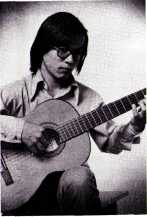 |
A tape sent CGI by Lois Shishido impressed me with the "flow" of his music, and his very accurate rhythmic interpretation, a credit to his work on the Manual, as well as Advanced Rhythms, being prepared for publication. His rhythmic accuracy gives an interpretation to music that seems to escape most recording artists. My only regret is that I have not yet seen him in concert. Ruth Mock
An Ark Lark
John W. Duarte, Some of Noah's Ark (op. 55), Ricordi.
|
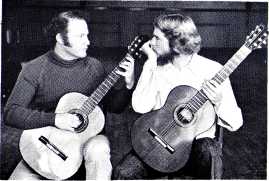 |
||
|
Read (left) with student Rawdon (story on pp. 24-26)
|
||||
|
YOSHIO MATSUMOTO
|
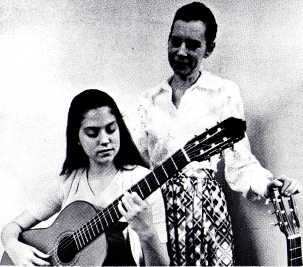 |
|||
|
This is a delightful collection of songs in which the music depicts the animal through interesting intervals and a humorous approach.
The tempo markings are realistic, and each song has a particular guitar technique involved, such as the chromatic passages of the "Snake," or the shifting of positions in the "Flea."
This is ideal recital material for the second year student. Children love these animal sketches, and the adult, too, will find them irresistible. Musical, guitaristic, not difficult, and just simply fun. Ruth Mock
Music, art center
Patrick Read of Laguna Beach, CA, initiated a unique center combining music and art under one roof. Reed and Marfa Calvo from Leon, Spain, rented an abandoned dress factory for their Laguna Beach Music and Art Center. The center includes teaching rooms and a recital hall which also serves as an exhibition room and art studio.
(continued on page 26)
|
||||
|
Charlotte Bruening and daughter Nancy (story on page 26)
|
||||
|
|
||||
|
|
||||
|
Creative Guitar International
|
26
|
27
|
||
|
|
||||
|
"We believe that art and music students can share practical knowledge about what they are doing, as well as a spiritual communion," Read wrote. He pointed out that painter Robert Henri's book, The Art Spirit, talks as much about music as it does about art.
Read has given several programs recently of special interest, including voice and guitar, and a duo-solo performance with Robert Rawdon, a student of Read's who is studying in Spain this fall. (See picture, p. 25 )
|
Current Discography
|
|||
|
Compiled by John W. Tanno* ALFONSO, NICOLAS et ILSE
ALPHA DB 85. Recital Use et Nicolas Alfonso: Duo de Guitares. BROUWER, LEO
DGG 2530307. Musique Contemporaine pour Guitare.
ERATO STU 70876. Domenico Scarlatti. (Florilege de la Guitare, 17). BOYD, LIONA BOOT BMC 3002. The Guitar. DIAZ, ALIRIO
MUSIDISC RC 784. 4 Siecles de Guitare classique. DINTRICH, MICHEL
MUSIDISC 16001. Les Immortels Interprets par Michel Dintrich. (Guitare 10 cordes), with orchestra. An album of two discs.
MUSIDISC RC 626. Le guitariste du siecle; Michel Dintrich (Guitare 10 cordes). Italie-AmeYique Latine. GARZIA, PASQUALINO & CARFAGNA, CARLO PYE GSGC 14154. Guitar Duos. ITURRI, RAFAEL
ALPHA DB 144C. Recital de guitare. IVANOV-KRAMSKOI, ALEXANDRE
LE CHANT DU MONDE LDX 78519. Boccherini & Paganini, with Edouard Gratch and Victor Dantchenko, violins; Vitali Sitkovetski, viola; Victor Simon, violoncello. MELODIA CM 03111. String Instruments.
LAGOYA, ALEXANDRE PHILIPS 6599760. Lagoya: Oeuvres de Albe'niz, Scarlatti, Schubert, Sor, Torroba, Turina
* Music Librarian at the University of California at Riverside.
|
||||
|
Teacher's aid
Charlotte Bruening of Oxford, Miss., wrote: "...often teachers are apologetic, insecure or on the defensive about their work... if the teacher really cares, the student will learn and learn eagerly.. .then too, most musicians would rather play than teach. An unfortunately large number look upon teaching only as a source of bread and butter .. .About ten years ago I lost the use of my hands completely for about a year. Eventually I resumed teaching a very few students mostly as my own personal little therapy technique (if I'm never going to be able to play again then best I get somebody else on with it)... I had to ferret out the problems intellectually because for a long time I couldn't "show and tell.'"
Charlotte's Management Manual directs attention to the following areas: Efficient communication of routine information to students and parents, organization of pedagogical materials, and record keeping. (She wrote of the need for "light, unscholarly, unresearched, down-home articles aimed at teachers...") Her advice to teachers is sound and well worth reading and involves the student and the teacher in relation to the community. She said that the successful teacher needs to spend the lesson time "free from the distractions of disorganization." She outlines step by step her procedures and practices which cannot but help the new guitar teacher, and give the older teacher some new ideas. A welcome manual for the guitar teacher.
Bruening is shown with her daughter Nancy (page 25), who does extensive volunteer community work as a performer. Ruth Mock
|
||||
|
|
||||
|
|
|||||
|
Creative Guitar Internationa!
|
28
|
29
|
|||
|
|
|||||
|
LEMAIGRE, PHILIPPE
ALPHA DB 208. Recital de Guitare Philippe Lemaigre: Fernando
Sor et H. Villa-Lobos. MAROTO, SEBASTIAN
MUSIDISC 16006. Recital de Guitare. An album of two discs. NAVASCUES, SANTIAGO
EURO DISC 86852. Spanische Gitarrenmusik: Santiago Navascu£s spielt Sor und Villa-Lobos.
EURODISC 86853. Spanische Gitarrenmusik: Santiago NavascuSs spielt Albeniz, ed Falla, Rodrigo, Sanz, Turina.
OHLSEN, OSCAR ANGEL 35ACX-47586. Del renacimientoal Barroco: Oscar Ohlsen, laud y guitara.
SANTOS, TURIBIO ERATO STU 70885. J.S. Bach. (Florilege de la Guitare, 18).
SAO MARCOS, MARIA LIVIA BAM LD5813. Heitor Villa-Lobos. TARRAGO, RENATA
COLUMBIA (ALHAMBRA) CS 8567. Renata Tarrag6. WALKER, LOUISE
SUPRAPHON 1111230. Louise Walker Guitar Recital. WALKER, TIMOTHY
L'OISEAU-LYRE DSLO 3. Timothy Walker Guitar Recital. YEPES, NARCISO
COLUMBIA CS 8564. Narciso Yepes Recital de Guitarra.
The listing of a recording in this discography does not constitute a recommendation, especially since a few of them are definitely below contemporary standards. The list was compiled merely as an enumeration of what is available. Several readers have inquired as to where recordings listed in this column may be acquired. All recordings listed to date were purchased from: Vogue Records and Tapes, 1025 Westwood Blvd., Westwood Village,Los Angeles, CA90024.
Since Creative Guitar International began publication in Fall, 1973, the size of the type has decreased; the number of pages, production and mailing costs have increased. As of May 1, 1976, the price of CGI will be $8.50 for one year, $16 for two years and $3 for back issues; all orders and renewals beginning May 1 will be under the new price schedule. Due to the concert tour of the five Mocks in guitar ensemble, deadlines will be: Winter issue, Dec. 7; Spring issue, April 1; and Fall issue, Aug. 7.
|
Guitar in Poland
|
||||
|
By Frank Wagner
Research Editor Josef Powrozniak is professor of guitar and director of the Graduate School of Music in Katowice, Poland. He has published collections of Polish guitar music, as well as a monograph, Guitar From A to Z, in 1957. Powrozniak also wrote an article "Die Gitarre in Polen," which appeared in the newsletter Gitarre, published by Preissler Verlag, 8000 Munchen 2, Brauhausstrasse 8, Germany, and sent to CGI by Polish correspondent Ryszard Pawtowski. |
|||||
|
According to Powrozniak, Feliks Horecki, who studied under Mauro Giuliani in Vienna, was one of the first Polish guitarists of international stature. He gave concerts in Austria, Germany,
|
 |
||||
|
France and England. He settled
|
|||||
|
in Edinburgh, Scotland as a
|
PUBLICATIONS RECEIVED
|
||||
|
guitar teacher. He published over 150 works. He died in 1870.
Jan Nepomucen Bobrowicz (1805-1881), studied under, and composed in the style of, Giuliani. As a concert virtuoso, he performed in the Leipzig Gewandhaus.
A student of Horecki's was Stanislaw Prus Szczepanowski (1814-1875), who also studied under Fernando Sor in Paris and concertized in Europe and the Mideast. He also composed.
Marek Konrad Sokolowski(1818-1883)had studied violin, cello and piano, but was intrigued with an old guitar he found in a warehouse. He made his debut on guitar May 26, 1841, soon was concertizing in Poland and Russia. He spent 12 years in Moscow, where he once performed for an audience of 4,000.
Performances by Andres Segovia reawakened interest in the classic guitar around 1950. A guitar society was formed in Warsaw in 1957, and in 1964 a center for guitar under Kazimierz Sosinski was organized by the Ludowy Instytut
|
|||||
|
|
|||||
|
|
|||
|
Creative Guitar International 30
Muzyczny in Lodz. First graduates, who often perform, include Aleksander Kowalczyk, Janusz Paterek, and Barbara Czyz.
Polish guitar competitions were held in 1970 and 1973. Interest in composition has grown. For example, Wlodzimir Kotonski composed a Trio for flute, guitar and percussion in a contemporary idiom with novel sound effects. Other composers include W.Szalonek, J. Swiderand J. Podobinski.
In 1974 Siegfried Behrend introduced Capriccio for Siegfried to the Polish Composers Union during a concert of 20th century guitar music at the Warsaw Winter Festival. The piece was written by the Polish contemporary music composer Krzysztof Penderecki.
SPRINGFIELD SOCIETY NEWSLETTER
Classical Guitar Society, Springfield (Mo.) Newsletter, 1225 S. Weller, Springfield, MO 65804.
|
31
|
||
|
PALMA DE MALLORCA
Guitar activity abounds on Palma de Mallorca, off the Mediterranean coast of Spain, including the first annual Andres Segovia Competition (International) in progress in October, instigated by the city of Palma. One of the founders of the competition is Gabriel Estarellas of Mallorca. Peter Burr sponsors an annual summer guitar workshop at his El Centro de Guitarra, as well as recitals.
COLORADO SOCIETY COMPETITION
Ned Sublette of New Mexico was winner of the first annual Rocky Mountain Guitar Competition held by the Colorado Guitar Society (Classic division). Suzanne McLean of Greeley was second and Mike Peterson of Denver, third. The judges also performed on the final night. Jay Rothman, society president, played his composition of Brazilian impressions. Vaughn Aandahlwrote in the Colorado Guitar Society Newsletter that "Lowell Thornton is to be warmly congratulated for successfully organizing a splendid first annual Rocky Mountain Guitar Competition."
ANGEL ARELLANO GONZALEZ PERFORMS IN MEXICO
Angel Arellano Gonzalez performed his improvisations on guitar for a Mexican TV program about a mural begun (and unfinished) in the Belles Artes of San Miguel de Allende by his friend, David Alfaro Siqueiros.
GRANTS FOR GUITAR WORKSHOP
|
|||
|
Events: Holland
|
|||
|
The annual guitar day in Holland became international this year, and included a lute recital of Renaissance and Baroque music at the Amsterdam Conservatory.
The recital was by Gusta Goldschmidt and Rob Faverey of Surinam.
The contest between guitar ensembles for the "Ida Presti" challenge cup included duos, trios and larger ensembles. A Danish duo of 15-year-olds won with a tango by Albeniz and the Danish Rondo Amoroso Sererud.
Dieter Henze, German guitar maker, spoke about construction.
A duo of Tom Burmanje, guitarist, and Marianne Dijkman onflute performed. Jorge Oraison performed South American music on the guitar, and the trio of Dick Visser, Theo Krumeich and Emile Hopman performed contemporary guitar music. From a letter by Andre' Ong-Alok, Holland .
|
|||
|
The Guitar Workshop of Roslyn Heights, N.Y. has been awarded grants totalling $35,000 for programs for fiscal 1975-76, which include classic guitar concerts.
The grants are from the New York State Council on the Arts ($25,000) and the National Endowment for the Arts ($10,000). A series of special concert events to be held at C. W. Post College in Brookville, Long Island, will include major classical guitarists.
|
|||
|
|
|||
|
|
||||
|
32
|
||||
|
|
||||
|
33
|
||||
|
|
||||
|
On campus: Music, art offered
|
SOUTHWEST MISSOURI STATE UNIVERSITY
|
|||
|
|
||||
|
Spring Hill College, Mobile, AL, offers a BA in fine arts. The Rev. Daniel Creagan wrote the program is "sufficiently flexible to include classic guitar, music theory and history, studio art and art history. We offer no music degree.. .We have had students take a minor in guitar here; and of course we do give credit in guitar." Creagan teaches guitar at Spring Hill and is head of the Department of Fine Arts.
|
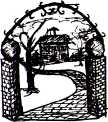 |
The Springfield, Mo., Classical Guitar Society Newsletter, sent by Nancy White, reports that Southwest Missouri State University (SMSU) has initiated a guitar degree program under Mike Madden. The program includes a course of study for guitar majors, and a class "introduction to classical guitar and which will be concerned with the history., .status, repertoire and basic techniques of the instrument."
The SMSU program is in contrast to schools which have initiated courses in strumming and non-note reading in disregard of the opportunity to teach musicality and the potential value of the instrument. Does someone know of a college which teaches chord piano without note reading for credit?
Nancy White reported that the society was able to instigate the program at SMSU, and on one occasion rented a van for 15 members to attend a program in Rolla by Christopher Parkening.
By Graham Wade*
The spring and summer months in England are usually hectic times for guitarists. First comes the March and April onslaught of concerts when many international guitarists visit Britain at the end of the concert season; this year Alirio Diaz, Narciso Yepes, Oscar Ghiglia, LeoWitoszynski, the Bream-Williams duo, and the Japanese "Daughters of Heaven" (guitar ensemble), all gave recitals in London and elsewhere during late spring.
There was also a host of concerts by well-known British .guitarists such as Anthea Gifford, Carlos Bonell, the Omega Guitar Quartet, and the Remirez-Kalamuniak duo, to mention but a few. This high level of concert activity demonstrates the enormous enthusiasm in England for the classic guitar; now and again the critics become glutted with the weekly diet of guitar concerts and grumble a little, but fortunately for lovers of the guitar the bandwagon goes rolling on.
|
||
|
ROOSEVELT UNIVERSITY
Pamela Kimmel wrote that the guitar course at Chicago Musical College of Roosevelt University includes ensemble, "where we play duos, trios and quartets."
PAN AMERICAN UNIVERSITY
John Ford has initiated a guitar program at Pan American University, Edinburg, Texas.
UNIVERSITY OF IDAHO
Gil Piger heads the classic guitar department at the University of Idaho at Moscow, according to the Seattle Classic Guitar Society Bulletin. Piger is a former member of the society. Other guitar instructors in the Seattle area, according to the Bulletin, are: Yasuko Endo, Seattle Pacific Col lege; Wynn Smith, Seattle University; Robert Flanary, North Seattle Community College; Frank Bliven, Western Washington State College (Bellingham); and Theo Bacchus, University of British Columbia (Vancouver, B.C.)
|
||||
|
DENVER UNIVERSITY
Sam Guarnacciahas developed a masters degree program at Denver University, according to the Colorado Guitar Society Newsletter.
|
||||
|
*Graham Wade has recently been appointed Lecturer in Guitar at the Leeds College of Music in Yorkshire, England.
|
||||
|
|
||||
|
|
||||||
|
34
|
35
|
|||||
|
|
||||||
|
Summer is the time for summer schools and these are popular in England and through Europe. A summer school at Cannington, near Bristol was presided over by Michael Watson with guest tutor, Ricardo Fernandez Iznaola, who also gave two concerts. At Brant Broughton Summer School for Guitar, near Lincoln, with Graham Wade as tutor, we had concerts by John Mills, Julian Byzantine, Cheryl Grice, John Arran, Ricardo Fernandez Isnaola, Joy Hymen, Juan Martin and Graham Wade, in a bumper fortnight of guitar sounds. Other summer schools in the country were run by Julian Byzantine at Salisbury, and Gordon Croskey at Canford School, Dorset.
In Europe the biggest event was probably Julian Bream's series of master classes in Lucerne, Switzerland, closely followed by Diaz' summer school at Aries, France. These days there are summer courses in just about every European country and nearly all the great players are involved in one or the other of these occasions.
Letters: Performance risks
Segovia played here Feb. 5 and the concert filled our Ohio Theatre. Our last visit by the master was marred by a local photographer who snapped off three flash pictures in the first piece played despite the incredulous stares of the first 20 rows in the theatre. The third flash caused Segovia to stop abruptly, shake his head, wave his left hand from side to side and say "No! No flash pictures. "On this most recent visit I held my breath as he played through the "Prelude" of the D minor Suite of Robert de Visee. No flashes! But just as I was beginning to exhale in relief that the local crowd did not applaud the "Prelude" either, someone downstairs treated us to an instant playback of it on his portable Sony. Segovia was visibly startled, and befuddled as well I think, since he did not comment but just went on with the Suite. I think many people here are conditioned to behave everywhere as they would at an Ohio State football game. I remember other incidents— the conductor of the Prague Symphony first glowering, then trying to stop them by lifting his baton immediately after a movement ended; then in desperation asking the audience not to applaud between movements. The last work on the program was the New World Symphony of Dvorak which is connected between the third and fourth movements, (continued on page 36)
|
CLASSIC GUITAR TEACHER DIRECTORY
Three consecutive insertions, fall, spring and winter, $7.50 for name or studio with address. Extra words $1. Phone $1. Society listings, 3 consecutive, $7.50 for name and address. Extra words $1 each. Send to: Creative Guitar International, Edinburg, TX 78539, USA
|
|||||
|
DONNA CURRY
(Lute, Baroque Guitar)
P.O. Box 194
Topanga, Cal. 90290 3-2
JIM FORREST GUITAR STUDIOS
|
LENORE JACKSON 1500 East Side #119 Austin, Tex. 78704
HAL KINNAMAN P.O. Box 809 San Juan Capistrano, Cal. 92675
SONIAMICHELSON 6709 N. Mozart St., Chicago, Illinois 60645
RUTH & JERRY MOCK 903 West Van Week Edinburg, Texas 78539 Phone (512) 383-4735
LAGUNA BEACH MUSIC AND ART CENTER Patrick Read
2094 South Coast Highway Laguna Beach, Cal. 92651
CHARLES RICHARD
125 Belgrave Ave.
San Francisco, Cal. 94117
|
3-2
3-3 3-3
3-3 3-3
|
||||
|
6538 Reef ton Ave. Cypress, Cal. 90630 Phone (714) 892-2739
JOSEPH I. GALLUCCI 165 Augusta St., Irvington, NJ 07111
RICHARD GREENE College of Music Loyola University New Orleans, La. 70118
GUITAR GALLERY OF HOUSTON, INC. 1401 Richmond Avenue Houston, TX 77006 Phone (713) 528-5666
PAUL HINRICHS 144 W. Norwich Columbus, Ohio 43201 Phone (614) 299-4037
|
3-3 3-3
3-3
3-3 3-3
|
|||||
|
WANT ADS
BRUENING'S MANAGEMENT MANUAL, A Textbook of Studio Organization for the Professional Teacher of Guitar, $4.75. To order send check or money order to Box 331, University, Miss. 38677
CLASSIC GUITAR CENTER - Write for free discount catalogue on guitar music. 35 Dayton Lane, Englishtown, N.J. 07726
|
||||||
|
|
||||||
|
|
|||
|
37
|
|||
|
|
|||
|
36
and you can guess what happened.* Another time I remember an especially delicate ending to an adagio movement that tapered off from pianissimo to silence in a period of about 30 seconds—which was handled perfectly by the OSU chamber orchestra with an aleatoric assist by a gum-chewing music appreciation class note-taker who clicked her ball point pen randomly the whole time. Narciso Yepes played here with the R-TV orchestra this year and the audience contained a group of people who must have gotten lost on the way to the movie—they got up and went to the lobby at will throughout the concert.
Paul Hinrichs Columbus, Ohio
HONG KONG ATTENDANCE GOOD
C. C. Chang of Hong Kong wrote that attendance at recent guitar programs is generally good, in contrast to a recital given in 1962 by Siegfried Behrend.
Chang wrote that the school hall where the program took place "was only half filled with mainly orphans and the blind children from the various charity organizations and the population at large was hardly seen..."
Chang said that although musical education in Hong Kong is inadequate (see CGI, Vol. 2, #2, p. 30), it also is true for general education. He said plans are being made for a conservatory and "one hopes it will succeed and that guitar will be included in the curriculum."
TRAVELS FROM SINGAPORE FOR PERFORMANCE
C. P. Lim of Singapore wrote that he traveled to Hong Kong to hear Narciso Yepes perform during the annual Hong Kong Festival.
PROGRAM IN SWEDEN
Martin Giertz of Sweden wrote that he does a guitar radio program every fortnight. Giertz also is writing a paperback history of the guitar, to be published in early 1976.
*ln case you didn't guess, no one applauded when it was over.
|
CHILDREN TESTED IN GERMANY
|
||
|
Friedrich von Hoheneichen wrote that he tests young children as to their proficiency in finger coordination, hearing, etc. He is head of the recorder department and the first of five guitar teachers in a school under the mayor of Heidleberg, Germany.
LUTE SOCIETY LIBRARIAN
Nancy Carlin is the new microfilm librarian of the Lute Society of America, Inc. (see CGI, Vol. 2, #2, p. 7). The library address is now 1021 Clark Street, Santa Rosa, CA 95404. She wrote that the library includes microfilms of Baroque guitar sources, music for theorbo, and is seeking to add cittern and chittarone music, and 15th oentury chansonniers (for early Renaissance music with a single line lute part).
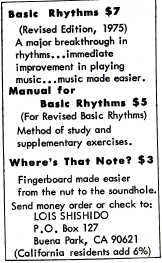 |
|||
|
ONE-DAY FESTIVAL
Michael Decker, guitar professor, wrote of a recent one-day guitar festival held at York College in York, Pa., which included a clinic on arranging, a lecture on guitar history, and a program on rock improvisation.
CARMEL PROGRAM RESET
The Classic Guitar Festival scheduled for Carmel, Cal., has been reset for Feb. 12-14, wrote Terrence C. M. Farrell. The festival originally was scheduled in November.
|
|||
|
|
|||
|
|
||||
|
38
|
||||
|
|
||||
|
BOOKS ON GUITAR BUILDING
I would like some information on technical books concerning the building of guitars.
Eldon G. Hoiness Harmony, MN.
(Editor's note: Two such books are Classic Guitar Construction by Irving Sloan, published by E. P. Dutton & Co., and Classic Guitar Making by Arthur E. Overholtzer, privately printed for the author, of 618 Orient Street, Chico, CA 95926.)
LOPATEGUI OF SPAIN RECORDS SOR
Maricarmen Pajma of Tiento, Barcelona, Spain, wrote that José Luis Lopátegui has recorded works by Sor (Opus 31 and 35), available soon in the U.S. Lopategui has revised and fingered the works: Doce Estudios Progressivos, Op. 31, and Doce Estudios, Op. 35, published by Tiento.
|
BACK ISSUES, Creative Guitar International available, $2.50 each. Here are some highlights (# indicates number, 3 each volume);
Volume 1
#1 Problems of teaching children; practicing and performing as duo. #2 How to approach Sagreras; Guitar in Mexico; Chamber music. #3 Tape recording the lesson; Merits and drawbacks of conservatory training; Artist management; Duo-trio guitar lists. Volume 2
#1 Helps in rhythm, note reading, practice; In search of the sixth string; Teaching the very young; Guitar on campus. #2 How nylon strings started; On sources for music; Tablatures; libraries; Stravinsky on four guitars; "Apuntes" for four guitars. #3 International guitar ensemble; grants available; Bartók and Tansman; Sensier's double back guitar; Current discography; The sound and the strings (the physics of strings with scaning electron microscope closeups.) FUTURE ISSUES will include stories on Alirio Diaz, Leo Brouwer, John Duarte, "Music in the Mountains, "More about strings; A graphite top.
PREPAID WANT ADS: 30 cents a word. Minimum 15 words. THE MOCK FAMILY CLASSIC GUITAR METHOD (Vol. 1, age3-adult) $5.95. Easy keys, A and D. Solo and ensemble music. Valuable for teaching beginners of all ages. Douglas W. Smith of the MacPhail Center for the Performing Arts, Minneapolis, wrote that ".. .the choice of literature and its gradual development is both excellent and appealing." Friedrich von Hoheneichen of Heidelberg, Germany, put it another way: ".. .the progressive order is very good. " SAVE $2 on unbeatable, completely fingered combination, MOCK method, Vol. 1 and Sagreras, Vol. 1, $7.45. Sagreras alone is $3.50, including shipping. Dept. 50, Edinburg, TX 78539, USA
TRAVELLING EAST—The Mock Family Guitar Ensemble (5 classic guitarists including Julian 5, Nelson 7, Melody 9). May l-30 we will perform through Texas, Louisiana, Mississippi, Georgia, South and North Carolina, Virginia, New Jersey and New York; June 1- mid July, Western Europe including England and Spain; mid-July to mid-August, New York, Pennsylvania, Ohio, Illinois, Missouri, Arkansas; including music of Biberian, Duarte, Maxson, Marx, Van der Staak, for universities, museums, libraries, guitar societies. If you are interested in a performance, write - Edinburg, TX 78539.
|
|||
|
Excellent Guitars
by renown Spanish Luthiers including works by: Jose Ramirez, Antonio Marin Montero, Felix Manzanero, Manuel Contreras, and others. Also, THE CLASSIC GUITAR METHOD of HALKINNAMAN, Vol. 1, an innovative approach to basic guitar technique. Price: $2.70. $3 foreign postpaid. For information write to the
Guitar Institute
Box 2746, Dept. 12,
Seal Beach,
California 90740, U.S.A.
|
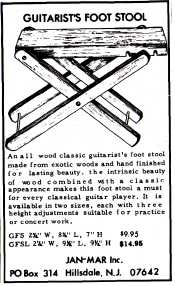 |
|||
|
|
||||